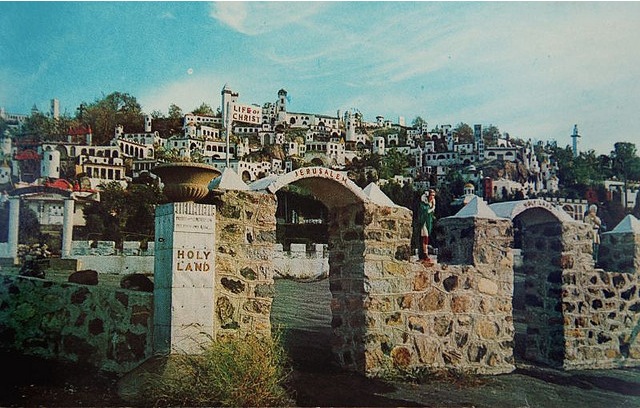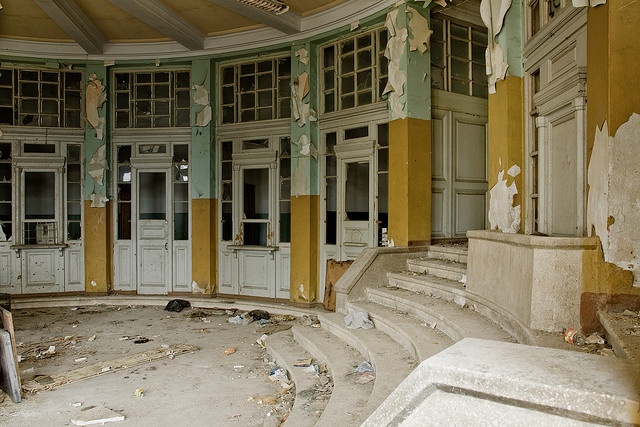https://ift.tt/2Km9voD
There are countless reasons a once bustling location could be abandoned. War, climate change, famine, economic instability, even religion. Whatever the cause, these places have become shadows of their former selves, reminding us that everything will inevitably come to an end.
10. Fengdu Ghost City
Dating back more than 2000 years, this abandoned Chinese city is located on the banks of the Yangtze River and is considered by the locals to be the home of the devil and the entrance into the underworld. Fengdu is believed to have been founded during the Han Dynasty by two men, Yin and Wang, who became Taoist hermits.
Later, during the Tang Dynasty (618-906 AD), Fengdu earned its reputation as a place where the dead reside and became a famous Taoist burial ground. This is also when it became common knowledge that Fengdu was home to the “King of Darkness,” or “YinWang” after its two founders.
Since the completion of the Three Gorges Dam the lower part of the city has been submerged underwater. That made access to the Ghost City for tourists much easier thanks to direct access from the Yangtze River. The upper temple complex has become a popular attraction, and is filled with bright statues depicting all sorts of devils and demons torturing souls in the afterlife. Among the many Taoist temples and shrines you can also find the stone statue of “The Ghost King,” which holds the Guinness World Record for the biggest sculpture carved within a single rock.
9. Kayakoy
An ancient deserted town near the Taurus Mountains in Southwestern Turkey, Kayakoy was once the home of over 20,000 Greeks. Today it lays in ruin due to political strife that took place almost a century ago. After World War I and the collapse of the Ottoman Empire, Greece and Turkey plunged into their own war for land grabbing. The result was a mutual compulsory population exchange where some 200,000 Greeks and over 300,000 Turks were forcibly removed from their homes.
Built in the 1700s with the original name of Karmylassos, the town’s buildings are now roofless and weathered by neglect and the elements. An entire community of people who lived peacefully with their Muslim neighbors were sent to war-torn Greece to start anew and escape persecution for something they had nothing to do with.
Today, the town’s surviving 350 homes and two Christian Orthodox churches look ancient. They’re a testament to how short our human legacy can be in the face of nature. A museum that tells the story of the town is all that’s left in Kayakoy.
8. Sathorn Unique Skyscraper
In the early 1990s, Thailand was experiencing one of its biggest booms in history. During this time of plenty, Bangkok began to show off its stability in the form of the construction of tall buildings. But Thailand’s economic success came to an end during the Asian Financial Crisis of 1997 — the money literally ran out overnight, and construction of the Sathorn Unique Skyscraper stopped dead in its tracks just months before completion.
This 49 story residential complex sits all alone overlooking Bangkok’s grand cityscape and the Chaopraya River. Entering it is forbidden and dangerous, with many floors collapsing at a mere touch. Today, Thailand has recovered and many other skyscrapers have risen. But Sathorn’s fate remains uncertain, since finishing it would cost more than starting a new one. And then there’s the fact that it has a reputation for being haunted…
7. Covasna Inclined Plane
Located at the border between the former Austro-Hungarian Empire and the Romanian Principality, the small town of Covasna was an important industrial center for forestry and timber production. In 1890 an entire network of railways was constructed, connecting Covasna with the rest of the country.
Within this network of railways, a system of pulleys was devised that could bring a wagon full of timber down a mountain slope while pulling an empty one up, relying solely on gravity to do its job. At the middle point the tracks branch off in order for the wagons to pass each other, after which they reunite. This simple yet brilliant feat of human ingenuity was unique at the time, and can only be found in just a couple of other places around the world.
Unfortunately, in 1995 a furious storm hit the region, bringing down most of the woods and the timber industry with it. Local authorities and wealthy regional investors had talked about a plan to revive the network of railways and the inclined plane system itself for tourist purposes, but nothing has been done yet due in large part to the economic crisis of 2008.
6. North Brother Island
Overlooking the East River just a few miles away from LaGuardia Airport, this once feared island is now completely forgotten by New Yorkers. Between the 1880s and 1930s it housed the Riverside Hospital, which was the last residence for many patients who suffered from smallpox, typhus, scarlet fever and leprosy. The notorious Typhoid Mary died there in 1938. Prior to its complete abandonment in 1963, the hospital was a rehab center for adolescent drug addicts.
Today, North Brother Island is essentially a nature reserve. The hospital still stands, but the inside is just a shell of what it once was. The windows are broken, the paint peeled off the walls and some roofs are collapsed. In 2008 the island came back into the public eye, when architect and photographer Christopher Payne documented the current state of the island.
5. Teufelsberg
This relic of the Cold War sits silently atop the highest peak in West Berlin. A listening station, it once kept an ear out for all radio traffic coming in and out of the Soviet half of the city. The hill itself was built in 1963 with the rubble left behind after World War II. The site was originally a Nazi military training school, which the Allies tried in vain to demolish and instead decided to bury under 120 meters of debris and wrecked houses which later became known as Devil’s Mountain.
Today, this derelict, graffiti covered building has exchanged many hands since the fall of the Berlin Wall. Among its owners was David Lynch, who had plans to build a meditation university, but the municipality of Berlin scuttled the plan. Others planned to build a luxury hotel and restaurant as well as a spy museum, but chances are that nothing will happen anytime soon. That’s good news for Cristopher McLarren, a former Teufelsberg employee who’s organizing weekend tours for spy enthusiasts.
4. Plymouth
Discovered by Christopher Columbus back in 1493, the 40 square mile Caribbean island of Montserrat is actually growing with each passing day. This may come as good news given the size of this tiny speck of land, but it’s also the reason why the entire southern part of the island is abandoned.
In 1995 and again in 1997, the once dormant Soufriere Hills volcano erupted and covered the city of Plymouth and the surrounding area in 4.6 feet of hot ash. Like the ancient city of Pompeii, most of Plymouth’s buildings, streets and cars are permanently locked into pyroclastic flows as hard as concrete. Luckily, most of the citizens were safely evacuated to the northern half of the island, but its tourist economy is literally in ashes, and with no hopes of revival in the near future given the state of the desolate land left behind.
3. Chateau Miranda
A once beautiful castle built in southern Belgium near the French border, this Neo-Gothic chateau now lays in ruins. During the French Revolution the politically active Liedekerke-Beaufort family had to leave their castle and move to a nearby farm to lay low and await the aftermath. Once everything was settled, they were ready to start anew and began the construction of Chateau Miranda in 1866.
Years passed by quietly until the last stages of World War II, when German troops occupied the region during the Battle of the Bulge. After the war, the Belgian National Railway company used it as a summer retreat for orphaned children up until the 1980s. With rising maintenance costs, the castle was abandoned in 1991. Four years later, a fire destroyed portions of the roof and the family stripped it of valuables, hardwood floors and Italian marble, relocating them to another castle in Italy.
Today, even after several offers to purchase and transform it into a hotel, it remains empty. Furthermore, the Liedekerke-Beauforts have put forward a formal request to demolish it. Whatever the outcome, Chateau Miranda is currently living its last days as a ruin.
2. Holy Land USA
In 1958, a Waterbury, Connecticut man named John Greco built a Bible theme park with reused materials. Surprisingly, the amusement park was a hit in the 1960s and ’70s, attracting more than 40,000 visitors every year. Among its main attractions were a miniature Bethlehem, the Nativity scene, Jerusalem, Christ’s crucifixion, Herod’s Palace, a 50 foot stainless steel cross visible from everywhere, and many Bible verses written in stone. In 1984, Mr. Greco decided to temporary close the park for refurbishment and expansion, but two years later he passed away and the park never re-opened.
1. Abkhazia Train Station
Once a popular tourist destination for the Russian elite, including Stalin himself, the region of Abkhazia just off the coast of the Black Sea has seen a steep decline in popularity and economic fortunes. Declaring independence from Georgia in 1999, Abkhazia is still a disputed territory.
Its economic problems can be seen everywhere, including the beautifully ornate train station at Sukhumi. Despite two decades of neglect, it still offers us a glimpse of what life for the Soviet upper class looked like. Mahogany shelving, beautiful marble columns and intricate plasterwork can still be seen, albeit in a state of decay.
The station is still occasionally visited by passenger trains, but because it’s close to the ceasefire line with Georgia it’s the end of the line. The region has seen major investments from Russia lately, which is looking to consolidate its influence in Abkhazia. Maybe it will be a bustling train stop once more.
The world is full of forgotten places.
TRENDS
TRENDS,AMAZING
via Toptenz.net http://www.toptenz.net
May 13, 2018 at 06:09PM
.png)











No comments:
Post a Comment